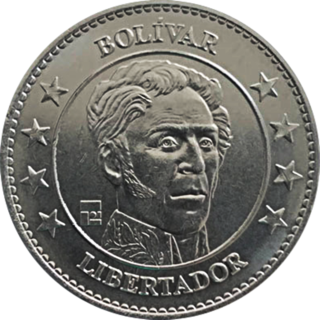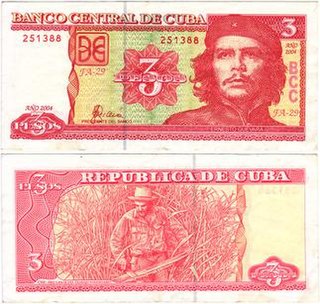
The peso is the monetary unit of several Spanish-speaking countries in Latin America, as well as the Philippines. Originating in the Spanish Empire, the word peso translates to "weight". In most countries of the Americas, the symbol commonly known as dollar sign, "$", was originally used as an abbreviation of "pesos" and later adopted by the dollar. The dollar itself actually originated from the peso or Spanish dollar in the late 18th century. The sign "₱" is used in the Philippines.

The bolívar is the official currency of Venezuela. Named after the hero of South American independence Simón Bolívar, it was introduced by President Guzman Blanco via the monetary reform of 1879, before which the venezolano was circulating. Due to its decades-long reliance on silver and gold standards, and then on a peg to the United States dollar, it was long considered among the most stable currencies.
The peso is the currency of Argentina since 1992, identified within Argentina by the symbol $ preceding the amount in the same way as many countries using peso or dollar currencies. It is subdivided into 100 centavos, but due to rapid inflation, coins and notes with a value lower than 500 pesos are now rarely used. Its ISO 4217 code is ARS. It replaced the austral at a rate of 10,000 australes to one peso.

The córdoba is the currency of Nicaragua and is divided into 100 centavos.

The Colombian peso is the currency of Colombia. Its ISO 4217 code is COP. The official peso symbol is $, with Col$. also being used to distinguish it from other peso- and dollar-denominated currencies.

The Cuban peso also known as moneda nacional, is the official currency of Cuba.
The boliviano is the currency of Bolivia. It is divided into 100 cents or centavos in Spanish. Boliviano was also the name of the currency of Bolivia between 1864 and 1963. From April 2018, the manager of the Central Bank of Bolivia, Pablo Ramos, announced the introduction of the new family of banknotes of the Plurinational State of Bolivia, started with the 10 Bs note, and then gradually arrived to introduce the 200 Bs note, presented in April 2019. The new family of banknotes of the Plurinational State received several awards such as "the best banknotes in Latin America", was highlighted by its security measures, its aesthetics and its inclusion of prominent figures in Bolivian history, being among those who awarded the "Latin American High Security Printing Press Conference".
The austral was the currency of Argentina between June 15, 1985, and December 31, 1991. It was divided into 100 centavos. The symbol was an uppercase A with an extra horizontal line, (₳). This symbol appeared on all coins issued in this currency, to distinguish them from earlier currencies.

The venezolano was the currency of Venezuela between 1872 and 1879. It was divided into 100 centavos, although the names céntimo and centésimo were also used. Venezolano was also the name of two currencies planned in 1854 and 1865.
The real was the currency of Argentina until 1881. From 1822, it was subdivided into 10 décimos. The sol was also issued during this period and was equal to the real, whilst the peso was worth 8 reales and the escudo was worth 16 reales.

The real was the currency of Peru until 1863. Sixteen silver reales equalled one gold escudo. The silver coin of 8 reales was also known as the peso.
The peso moneda nacional was the currency of Argentina from 5 November 1881 to 1 January 1970, the date in which the peso ley 18.188 was issued to the Argentine public. It was subdivided into 100 centavos, with the argentino worth 5 pesos. The peso was introduced to replace the Argentine peso moneda corriente at a rate of $+m⁄c 25 = m$n 1.

The Philippine peso fuerte was the first paper currency of the Philippines and the Spanish East Indies during the later Spanish colonial period. It co-circulated with other Spanish silver and gold coins and was issued by El Banco Español Filipino de Isabel II. The banknotes were convertible to either silver pesos or gold coins at the bank's discretion. The colonial government at the time allowed El Banco Español-Filipino to issue pesos fuertes up to one-fourths of its subscribed capital, or a maximum of PF 100,000, which was subsequently raised to 300,000 in 1855.

This is an outline of Uruguay's monetary history. For the present currency of Uruguay, see Uruguayan peso.

The currency of Venezuela has been in circulation since the end of the 18th century. The present currency unit in Venezuela is the Venezuelan bolívar.
Currency in Colombia denotes the ingots, coins, and banknotes that have been used in Colombia since 1622. It was in that year, under a licence purchased from King Philip III of Spain, that Alonso Turrillo de Yebra established a mint at Santa Fe de Bogotá and a branch mint at Cartagena de las Indias, where gold cobs were produced as part of Colombia's first currency. Silver milled coins date from 1627. In 1831, Gran Colombia dissolved into Venezuela and New Granada. In 1836, in New Granada, new monetary laws were passed, to standardise the money produced in the country. From 1861 to 1862, due to financial instability, the United States of New Granada accepted British currency, the name of the country becoming the United States of Colombia in 1862. In 1880, Colombia pegged the peso to the gold standard due to the falling price of silver. In 1886, the paper peso was introduced. In 1931, Colombia abandoned the gold standard and switched to the current form of the peso.
This article provides a historical summary of the currency used in Ecuador. The present currency of Ecuador is the United States dollar.

The first boliviano was the currency of Bolivia from 1864 to 1963. Due to rising inflation, it was replaced with the peso boliviano at an exchange rate of 1000 bolivianos to 1 peso. The peso was later replaced by the second Bolivian boliviano.
The Classical Monetary System of the Oriental Republic of Uruguay includes the coins minted by the Oriental Republic of Uruguay between the years 1840 and 1855 in the national territory. These coins were minted entirely within the city of Montevideo, first at the "Taller y Armería Jouve" owned by a French artisan named Agustín Jouve and later at the Casa de Moneda de Montevideo or Casa de Moneda Nacional, which was created for this purpose.
The Chilean peso was the legal tender of Chile from 1817 until 1960, when it was replaced by the escudo, a currency that was itself replaced in 1975 by a new peso.















































